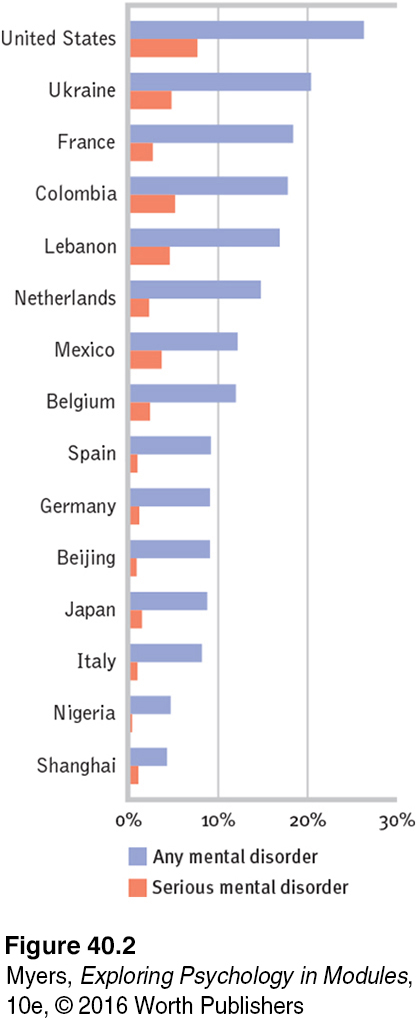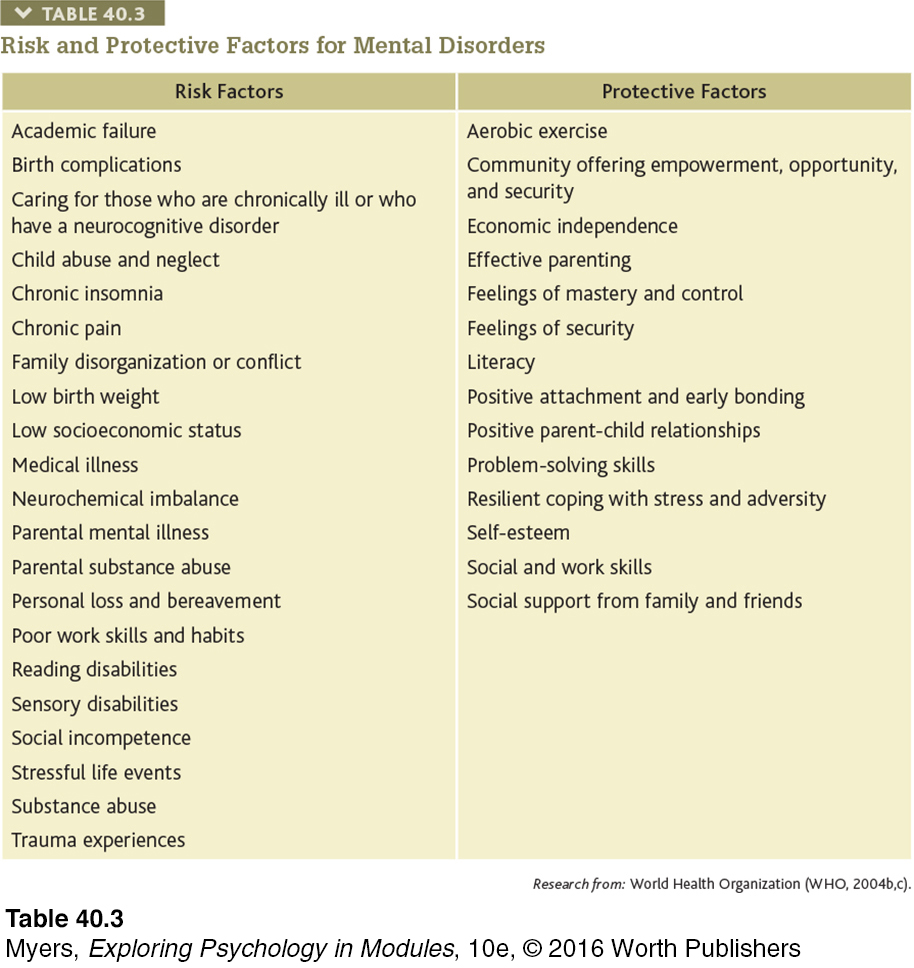40.3 Rates of Psychological Disorders
40-6 How many people have, or have had, a psychological disorder? Is poverty a risk factor?
Who is most vulnerable to psychological disorders? At what times of life? To answer such questions, various countries have conducted lengthy, structured interviews with representative samples of thousands of their citizens. After asking hundreds of questions that probe for symptoms—“Has there ever been a period of two weeks or more when you felt like you wanted to die?”—the researchers have estimated the current, prior-year, and lifetime prevalence of various disorders.
How many people have, or have had, a psychological disorder? More than most of us suppose:
The U.S. National Institute of Mental Health (2008, based on Kessler et al., 2005) has estimated that just over 1 in 4 adult Americans “suffer from a diagnosable mental disorder in a given year” (TABLE 40.2).
A World Health Organization (2004) study—based on 90-minute interviews of 60,463 people—estimated the number of prior-year mental disorders in 20 countries. As FIGURE 40.2 illustrates, the lowest rate of reported mental disorders was in China (Shanghai), the highest rate in the United States. Moreover, people immigrating to the United States from Mexico, Africa, and Asia averaged better mental health than their U.S. counterparts with the same ethnic heritage (Breslau et al., 2007; Maldonado-Molina et al., 2011). For example, compared with people who have recently immigrated from Mexico, Mexican-Americans born in the United States are at greater risk of mental disorder—a phenomenon known as the immigrant paradox (Schwartz et al., 2010).

Figure 14.2: FIGURE 40.2 Prior-year prevalence of disorders in selected areas From World Health Organization interviews in 20 countries (WHO, 2004a).
 See LaunchPad’s Video: Correlational Studies below for a helpful tutorial animation about this research design.
See LaunchPad’s Video: Correlational Studies below for a helpful tutorial animation about this research design.
What increases vulnerability to mental disorders? As we have seen, the answer varies with the disorder (TABLE 40.3). One predictor of mental disorders—poverty—crosses ethnic and gender lines. The incidence of serious psychological disorders has been doubly high among those below the poverty line (Centers for Disease Control, 1992). This correlation, like so many others, raises further questions: Does poverty cause disorders? Or do disorders cause poverty? It is both, though the answer varies with the disorder. Schizophrenia understandably leads to poverty. Yet the stresses and demoralization of poverty can also breed disorders, especially depression in women and substance abuse in men (Dohrenwend et al., 1992). In one natural experiment investigating the poverty-pathology link, researchers tracked rates of behavior problems in North Carolina Native American children as economic development enabled a dramatic reduction in their community’s poverty rate. As the study began, children of poverty exhibited more deviant and aggressive behaviors. After four years, children whose families had moved above the poverty line exhibited a 40 percent decrease in behavior problems. Those who maintained their previous positions below or above the poverty line exhibited no change (Costello et al., 2003).
At what times of life do disorders strike? Usually by early adulthood. “Over 75 percent of our sample with any disorder had experienced [their] first symptoms by age 24,” reported Lee Robins and Darrel Regier (1991, p. 331). Among the earliest to appear are the symptoms of antisocial personality disorder (median age 8) and of phobias (median age 10). Alcohol use disorder, obsessive-compulsive disorder, bipolar disorder, and schizophrenia symptoms appear at a median age near 20. Major depressive disorder often hits somewhat later, at a median age of 25.
RETRIEVE IT
Question
4d08JdF0hvVBhVjXmRWkdZ19mNwD9m5D7BwZM3CKAKWuHIClVCZ2GKKdeg1f63MgUv96LodvCNXdUoC/6IVdz8s4o7MWYgoFxoy3+A==
ANSWER: Poverty-related stresses can help trigger disorders, but disabling disorders can also contribute to poverty. Thus, poverty and disorder are often a chicken-and-egg situation: It's hard to know which came first.


 See LaunchPad’s Video: Correlational Studies below for a helpful tutorial animation about this research design.
See LaunchPad’s Video: Correlational Studies below for a helpful tutorial animation about this research design.